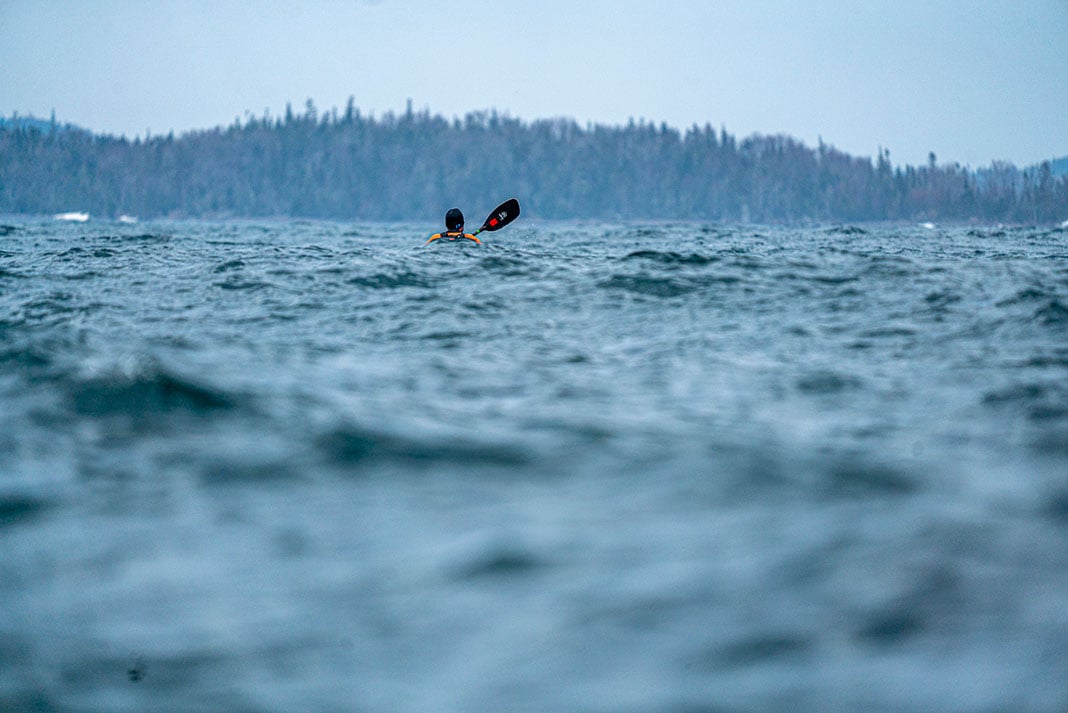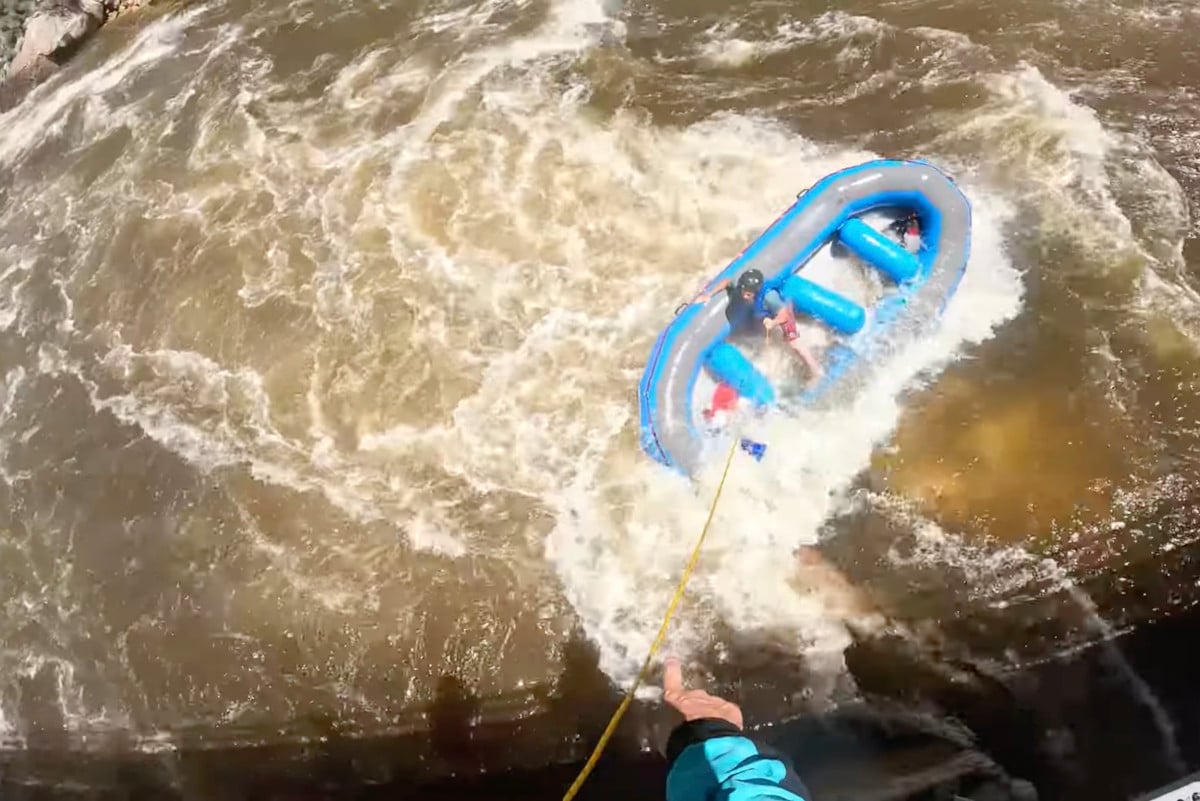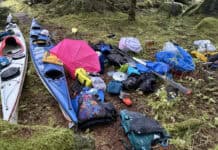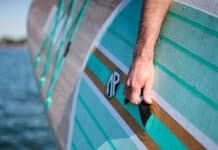On May 18, 2024, around midnight, Minnesota Department of Natural Resources pilot Grace Zeller landed her helicopter on a rock shelf in the Boundary Waters Canoe Area Wilderness (BWCAW). The mission: begin the evacuation of injured canoeists.
Overall, Zeller would make two flights into the BWCAW, transporting three medics and two canoeists. Because of her actions, Zeller was recognized in September for lifesaving efforts beyond the call of duty and awarded the Minnesota Department of Natural Resources Division of Enforcement Lifesaving Award.
Canoeists swept over falls in the Boundary Waters Canoe Area Wilderness
It was around 4 p.m. on May 18 when brothers Erik and Reis Grams watched their friends, Jesse Haugen and Kyle Sellers, approach Curtain Falls on Crooked Lake in the BWCAW. They witnessed the canoe move closer to the falls, then turn parallel to the falls, and then capsize. Immediately, Sellers went over with the canoe; Haugen, according to a report in the Minnesota Star Tribune, appeared to be standing in chest-deep water at the lip. None of the four were wearing PFDs or life jackets.
The Grams brothers approached cautiously, hoping to pull their friend from the top of the falls. Seconds later, all three went over the 30-foot cascade.
Erik Grams and Kyle Sellers survived the incident, sustaining a range of injuries including broken bones and hypothermia. Jesse Haugen and Reis Grams were missing.
Downstream, canoeists Tony Maynard and his friend Nick came upon Erik Grams and Kyle Sellers and immediately recognized the situation was serious. Maynard hiked back to high ground at the portage, where he remembered he had cell service, to call 911 to initiate the rescue. Later, Maynard and his friend also used a Garmin InReach to communicate with first responders as the rescue continued.
In all of this, there was a fifth member of the party with Sellers, Haugen and the Grams brothers, who had elected to sit out for an afternoon of fishing from shore. The group of five had paddled into the Boundary Waters with just two canoes, and were camped upstream of the falls. Maynard made a trip back upstream to let the friend know what had happened before returning downstream to his camp and the survivors before dark.
As the night wore on, Maynard and his friend focused on staying with the survivors, communicating with search and rescue and keeping the fire going. Sometime before midnight, they received a message through the Garmin InReach that a helicopter was coming.
Rescue in the remote Boundary Waters Canoe Area Wilderness
At the other end of the EMS system, in Brainerd, Minnesota, pilot Grace Zeller received a call in the night to see if she was willing and able to fly. She knew something bad had happened deep in the BWCAW, and there were no other aircraft available or able to access that location, but little was known beyond that.
“When Grace originally landed, she came in on the southwest side of the island and landed on a little tiny rock right in the middle of the river, and they couldn’t get to land from that rock,” Maynard explained.
“They had to go back up again and bring it to the other side of the little island and there’s just the perfect tiny little spot to land a helicopter. She was able to fit there and get them out that way. It was something I’ll probably never see again.”
Zeller made two trips into the BWCAW, first transporting an injured Sellers and two medics, then Erik Grams with an additional medic about an hour later.
In the morning, a float plane came to retrieve the group’s fifth member and volunteers from the St. Louis County Rescue Squad streamed in to begin the search for Jesse Haugen and Reis Grams, who were still missing.
Haugen’s body was recovered on May 31 and Reis Grams’ on June 2, 2024.
Overall, the St. Louis County Rescue Squad logged almost 6,000 hours during the rescue and recovery of the canoeists, making this the largest operation in the all-volunteer squad’s history.
According to Maynard, the information he provided to rescuers included the number of people involved, their injuries, location and landmarks, resources available and resources needed, and the fact that there were two people still missing.
“They needed to know where we were in the vicinity of Curtain Falls. They were able to see us probably a couple miles out because we had a fire going,” Maynard added.
After the incident, Maynard said he’s a lot more diligent in wearing his PFD on the water, and paying closer attention to conditions.
“I’m wearing it everywhere, even on a pond,” Maynard said.
According to Rick Slatten, captain of the St. Louis County Rescue Squad who responded to the incident, of the over 500 water fatalities in the squad’s history, less than three percent were wearing life jackets.
Pilot Grace Zeller receives state lifesaving award
On September 16, 2024, Zeller was honored for her rescue efforts above and beyond the call of duty with the Minnesota Department of Natural Resources Division of Enforcement Lifesaving Award.
“Normally, we’re just the search party. We don’t really get involved in the rescue part,” said Jacob Willis, Chief Enforcement Pilot, in a DNR video highlighting Zeller’s award.
Both Erik Grams, Kyle Sellers, and members of their families were present for the award ceremony.
“Most rescue pilots or EMS pilots, they don’t even get to know if their patient made it,” said Zeller following the award ceremony. “Not only did I get to do that, I got to meet their family members, and that is really special.”
Pilot Grace Zeller lands a helicopter in the BWCAW to evacuate two injured canoeists swept over a waterfall. | Featured photo: Tony Maynard










What an amazing rescue and story! My thoughts are with the families of the two that didn’t make it.